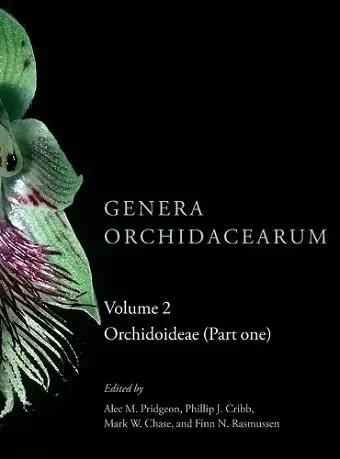Genera Orchidacearum: Volume 2. Orchidoideae (Part 1)
Alec M Pridgeon editor Phillip J Cribb editor Mark W Chase editor Finn Rasmussen editor
Format:Hardback
Publisher:Oxford University Press
Published:18th Jan '01
Currently unavailable, and unfortunately no date known when it will be back

Orchidaceae are the largest monocot family and likely the largest plant family in terms of number of species (ca. 20,000), but for a variety of reasons it remains one of the least understood: lack of a fossil record, relative scarcity of active research until recent years, size and geographical distribution of the family, and the largely tropical distribution of most, which hinders access. The early classifications and generic circumscriptions of Lindley (1830-1840), Bentham and Hooker (1883) and Schlechter (1927) relied mainly on morphological characters, especially floral features. The problem with such reliance on floral features at higher levels of classification is that floral morphology is extremely plastic in evolutionary terms, so that unrelated species may have developed similar structures in response to similar selection, particularly pollinator pressures. Such parallelisms are rife in Orchidaceae, so it is necessary to apply more objective criteria and character choices in trying to unravel the complexities of the family's history. Robert L. Dressler's (Phylogeny and Classification of the Orchid Family, Cambridge University Press, 1993) classification introduced characters from pollen, seeds, and anatomy to supplement traditional characters. The recent surge in molecular approaches, especially multigene analyses, combined with several other types of new data, had not only contradicted key elements of Dressler's concepts at higher levels but will result in the recircumscription of many genera. The aim of Genera Orchidacearum is therefore to produce a more robust and natural account of the orchids at the generic level, incorporate the wealth of new molecular data in a truly phylogenetic classification, and identify those areas and taxa that need additional work.
... this is a publication that truly reflects the current state of knowledge on almost every aspect of orchid biology, not just taxonomy. The quality of the line drawings ranges from good to excellent. I would like to single out those by Oliver Q. Whalley, which alone make the book worth purchasing ... much more than a taxonomic treatise. All biologists who work on orchids should have it close at hand. * Plant Systematics and Evolution *
This volume, as volume 1, is destined to be the standard against which other similar works will be compared. One cannot praise this work too highly nor to extol its virtues excessively. Genera Orchidacearum, volume 2, part 1 is a masterpiece. * Plant Science Bulletin *
... elegantly presented ... this work is undoubtedly of elevated scientific value and is able to satisfy the specialistic needs of the fascinating world of orchids. * Advances in Horticultural Science *
ISBN: 9780198507109
Dimensions: 287mm x 224mm x 30mm
Weight: 1563g
438 pages